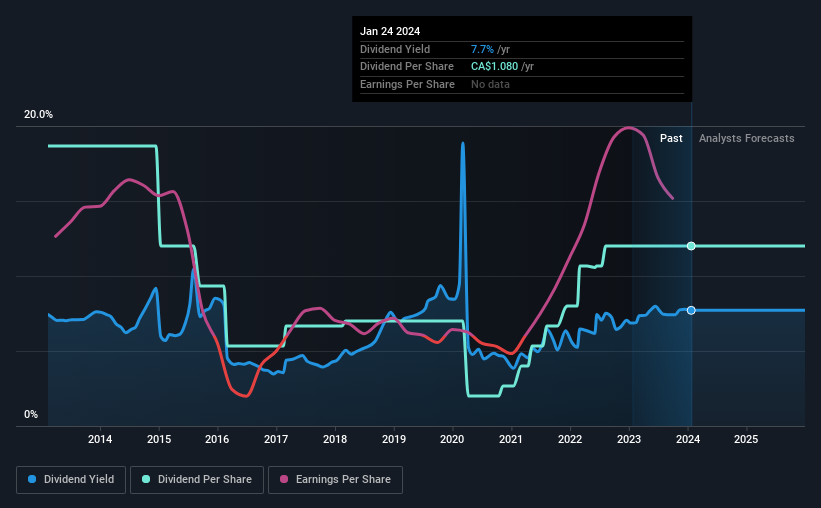Income Investors Should Know That Freehold Royalties Ltd. (TSE:FRU) Goes Ex-Dividend Soon
Freehold Royalties Ltd. (TSE:FRU) is about to trade ex-dividend in the next 4 days. Typically, the ex-dividend date is one business day before the record date which is the date on which a company determines the shareholders eligible to receive a dividend. The ex-dividend date is of consequence because whenever a stock is bought or sold, the trade takes at least two business day to settle. Meaning, you will need to purchase Freehold Royalties' shares before the 30th of January to receive the dividend, which will be paid on the 15th of February.
The company's next dividend payment will be CA$0.09 per share, and in the last 12 months, the company paid a total of CA$1.08 per share. Looking at the last 12 months of distributions, Freehold Royalties has a trailing yield of approximately 7.7% on its current stock price of CA$14.01. If you buy this business for its dividend, you should have an idea of whether Freehold Royalties's dividend is reliable and sustainable. So we need to check whether the dividend payments are covered, and if earnings are growing.
Check out our latest analysis for Freehold Royalties
Dividends are usually paid out of company profits, so if a company pays out more than it earned then its dividend is usually at greater risk of being cut. Freehold Royalties distributed an unsustainably high 118% of its profit as dividends to shareholders last year. Without extenuating circumstances, we'd consider the dividend at risk of a cut. Yet cash flow is typically more important than profit for assessing dividend sustainability, so we should always check if the company generated enough cash to afford its dividend. Over the last year, it paid out more than three-quarters (76%) of its free cash flow generated, which is fairly high and may be starting to limit reinvestment in the business.
It's disappointing to see that the dividend was not covered by profits, but cash is more important from a dividend sustainability perspective, and Freehold Royalties fortunately did generate enough cash to fund its dividend. Still, if the company repeatedly paid a dividend greater than its profits, we'd be concerned. Extraordinarily few companies are capable of persistently paying a dividend that is greater than their profits.
Click here to see the company's payout ratio, plus analyst estimates of its future dividends.
Have Earnings And Dividends Been Growing?
Businesses with strong growth prospects usually make the best dividend payers, because it's easier to grow dividends when earnings per share are improving. If earnings decline and the company is forced to cut its dividend, investors could watch the value of their investment go up in smoke. That's why it's comforting to see Freehold Royalties's earnings have been skyrocketing, up 55% per annum for the past five years.
The main way most investors will assess a company's dividend prospects is by checking the historical rate of dividend growth. Freehold Royalties has seen its dividend decline 4.3% per annum on average over the past 10 years, which is not great to see. It's unusual to see earnings per share increasing at the same time as dividends per share have been in decline. We'd hope it's because the company is reinvesting heavily in its business, but it could also suggest business is lumpy.
Final Takeaway
From a dividend perspective, should investors buy or avoid Freehold Royalties? Freehold Royalties has been growing its earnings per share nicely, although judging by the difference between its profit and cashflow payout ratios, the company might have reported some write-offs over the last year. While it does have some good things going for it, we're a bit ambivalent and it would take more to convince us of Freehold Royalties's dividend merits.
If you're not too concerned about Freehold Royalties's ability to pay dividends, you should still be mindful of some of the other risks that this business faces. To that end, you should learn about the 2 warning signs we've spotted with Freehold Royalties (including 1 which doesn't sit too well with us).
A common investing mistake is buying the first interesting stock you see. Here you can find a full list of high-yield dividend stocks.
Have feedback on this article? Concerned about the content? Get in touch with us directly. Alternatively, email editorial-team (at) simplywallst.com.
This article by Simply Wall St is general in nature. We provide commentary based on historical data and analyst forecasts only using an unbiased methodology and our articles are not intended to be financial advice. It does not constitute a recommendation to buy or sell any stock, and does not take account of your objectives, or your financial situation. We aim to bring you long-term focused analysis driven by fundamental data. Note that our analysis may not factor in the latest price-sensitive company announcements or qualitative material. Simply Wall St has no position in any stocks mentioned.

